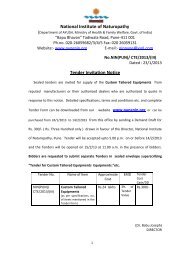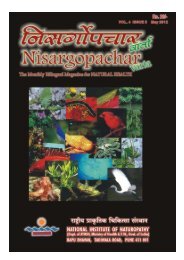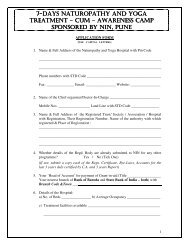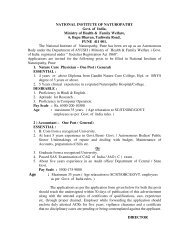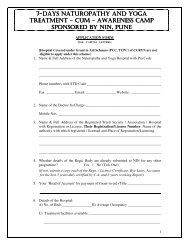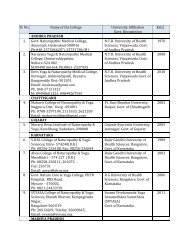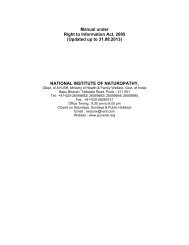Final cover.cdr - National Institute of Naturopathy Pune
Final cover.cdr - National Institute of Naturopathy Pune
Final cover.cdr - National Institute of Naturopathy Pune
You also want an ePaper? Increase the reach of your titles
YUMPU automatically turns print PDFs into web optimized ePapers that Google loves.
how beneficial<br />
An antioxidant is a molecule that inhibits the<br />
oxidation <strong>of</strong> other molecules. In this article, we will<br />
discuss about the nature <strong>of</strong> oxidation process, the need<br />
to prevent oxidation and how these antioxidants achieve<br />
the goal <strong>of</strong> preventing oxidation with more relevance<br />
to athletes.<br />
Oxygen provides us with the energy required to<br />
sustain life, including the ability to power movements<br />
and muscular contraction. The ability <strong>of</strong> the body to<br />
absorb, transport and use oxygen is important to<br />
endurance athletes.<br />
The chemical reactivity <strong>of</strong> the oxygen molecules can<br />
also create cellular havoc by means <strong>of</strong> the highly reactive<br />
and potentially extremely destructive molecular species<br />
which are called free radicals. These free radicals are<br />
produced as a consequence <strong>of</strong> trapping the chemical<br />
energy <strong>of</strong> oxygen within the body. A free radical is simply<br />
a molecule that contains an unpaired electron which<br />
then runs free in our bodies breaking down good cells.<br />
This free radical damage peaks after exercise which<br />
increases muscle soreness. Such damages are also<br />
thought to be one <strong>of</strong> the root cause <strong>of</strong> degenerative<br />
diseases, inflammation and the ageing process in<br />
general.<br />
Dr. T. Arun Kumar<br />
Athletes not only take in a<br />
larger volume <strong>of</strong> oxygen<br />
but also utilize it at a higher<br />
rate. During training and<br />
performance, the rate <strong>of</strong><br />
oxygen processing by the<br />
mitochondria is very high<br />
placing exceptionally high<br />
demands on antioxidant<br />
defence systems.<br />
Athletes not only take in a larger volume <strong>of</strong> oxygen<br />
but also utilize it at a higher rate. During training and<br />
performance, the rate <strong>of</strong> oxygen processing by the<br />
mitochondria is very high placing exceptionally high<br />
demands on antioxidant defence systems.<br />
However the human body is equipped with a number<br />
<strong>of</strong> systems capable <strong>of</strong> inhibiting the free radicals<br />
produced as a result <strong>of</strong> aerobic metabolism, and<br />
dissipating their energy harmlessly. These are collectively<br />
known as the antioxidants which are substances or<br />
vitamins that protect the cells in our body from such<br />
molecules like free radicals.<br />
Antioxidant nutrients (consumed in the diet) remove<br />
the unwanted free radical activity and break the chain<br />
<strong>of</strong> free radical reactions, thereby minimizing damage to<br />
the body. Increased consumption <strong>of</strong> antioxidant<br />
nutrients automatically leads to reduction <strong>of</strong> free<br />
radicals by neutralising it. Vitamins E and C as well as<br />
Selenium block the body’s ability to make free radicals<br />
24<br />
Nisargopachar Varta : January 2013




